Toshiba Satellite L645D: Mobile AMD at 3GHz
by Dustin Sklavos on March 9, 2011 3:20 AM ESTMostly Portable
A point where AMD-based notebooks have traditionally suffered (with the notable exceptions of both Sony's EE34 and pretty much anything Fusion-based) is battery running time. Toshiba equips the L645D with a mediocre six-cell, 48Wh battery that may somewhat dampen the mobility of a notebook that's otherwise fairly portable.

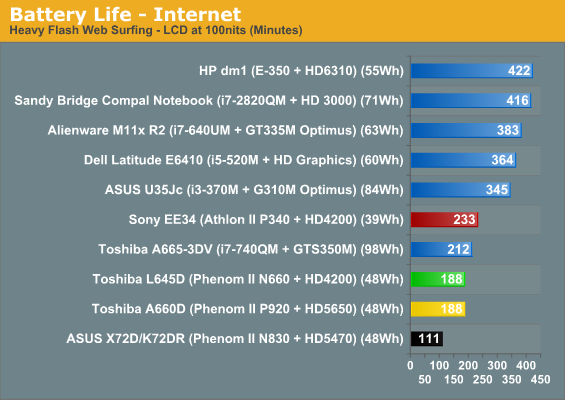
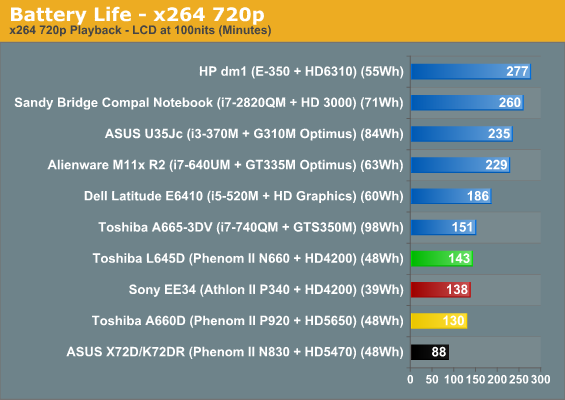

The relative battery life of the L645D isn't completely dire, but the Sony EE34's 25-watt processor runs roughshod over it. In practice, though, the L645D is still able to achieve three hours of useful running time surfing the internet. This is something Jarred's mentioned before and we've discussed at length: if you look at the running times of the Intel-based notebooks, you'll notice they're all equipped with much larger batteries. It seems like manufacturers almost deliberately cripple AMD-based notebooks.
We're not suggesting the L645D would offer battery life on par with an equivalent Intel machine, but it's still hamstrung by a middling battery. It's also clear there are power optimizations left on the table, as the Sony EE34 posts better battery life in two of the three tests despite having a smaller battery; the H.264 playback test is closer to what we'd expect, but the Internet test in particular has Sony leading by over 50% in relative battery life.
Heat and Noise
Given the smaller chassis of the L645D compared to some of the larger notebooks we've reviewed, it isn't unreasonable to expect it's going to have a tougher time dealing with the thermals of the Phenom II N660. We were pleasantly surprised.
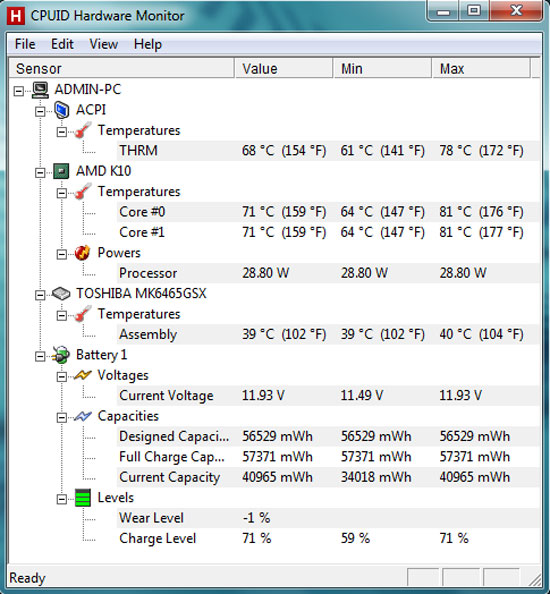
The processor temperatures are going to seem a little alarming, but they're not too far from where we've seen Arrandale-based notebooks hit. It may be better to look at the hard drive's temperature, which remains constant under both idle and load: 40C is perfectly reasonable. The L645D isn't in danger of overheating.
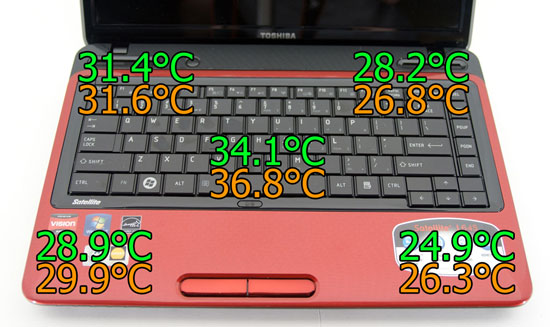
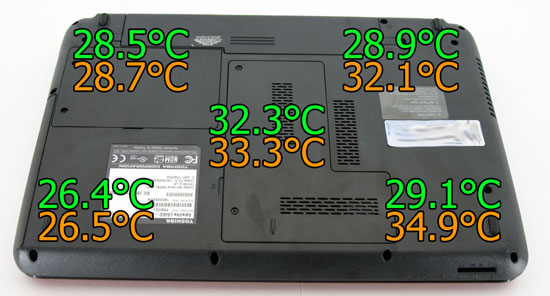
Idle and load surface temperatures are a little hotter than some of the other notebooks we've reviewed recently, but still nothing to complain about. Palmrests remain comfortably cool, as does the bottom of the notebook, with the center of the keyboard getting the hottest under sustained load. The central hot spot's 36.8C equates to roughly 100F, which is by no means cool but also not swelteringly hot either.
The L645D actually handles heat pretty well, and though the fan can definitely spin up noticeably under load, it's not aggravatingly loud and certainly not any louder than competing notebooks tend to be.










61 Comments
View All Comments
piroroadkill - Wednesday, March 9, 2011 - link
5400 RPM HDD, decent CPU hampered by terrible graphics, intentionally ruined graphics drivers, glossy screen, 10/100 ethernet?Pass.
XZerg - Wednesday, March 9, 2011 - link
no usb3 also.it feels like these guys and many others purposely f**k up on AMD version to ensure they make more even though they could have sold it at a much cheaper price with all the bells than what a similar config from intel would have been.
alent1234 - Wednesday, March 9, 2011 - link
it's $619. some people don't care about good graphics or USB3. some people just want a laptop to surf the internet and hold some datai just want something in the $600 range with a 15" screen, SB and 500GB hard drive. i use android and iOS a lot more than Windows so most of the time the laptop is off.
piroroadkill - Wednesday, March 9, 2011 - link
Then why the decent CPU?Why the blu-ray drive?
They're setting a standard the rest of the system utterly fails to match.
alent1234 - Wednesday, March 9, 2011 - link
because this stuff is dirt cheap now. it's not like they make this stuff up. they have projected selling prices and profits per unit. they get a bill of materials from suppliers before designing something and prices probably dropped so much they can put in more hardware and still sell for a low price.a lot of times it's cheaper to use a more expensive part but use less parts in your products overall. think apple. it makes logistics easier and cheaper. and since toshiba is part of the blu ray consortium they are pushing their other products with this
Sam125 - Wednesday, March 9, 2011 - link
I think AMD was the first to realize that there comes a point where going dirt cheap is kind of stupid when you end up with gimped/lopsided systems like this L645D which is why they're cutting the manufacturer out of the picture when it comes to choosing a balanced system architecture. That's why going SOC always made sense for AMD but not Intel.quiksilvr - Wednesday, March 9, 2011 - link
Seriously. Go to Newegg and look at the cheapest Core i3 laptops. They are all ProBookks that are mostly under $500. I'd rather get a slightly bigger laptop for less than gimp out just for "portability" (The Probooks are 5.25 lbs. That's plently portable enough)mino - Wednesday, March 9, 2011 - link
Sorry sir to spoil your party, but calling the second-best IGP (after Brazos) on the amrket a terribel graphics ?Well shall we talk about ALL those Intel notebooks (taking 50% of the market) selling with their IGP's ... who not only do not have the performance are not actually able to _run_most of the graphics stuff ?
Just remember, those Intel notebooks had a similar or faster CPU on board ... and sold for much higher prices ...
piroroadkill - Wednesday, March 9, 2011 - link
Do you think I'm anti-AMD or something?Because I'm not.
JarredWalton - Wednesday, March 9, 2011 - link
HD 4250 is hardly the "second-best" IGP. In order, the best IGPs at present are:GeForce 320M (only in MacBook)
HD 6310 (Brazos E-series)
Intel HD Graphics 3000 (not as compatible with games, but generally more than twice as fast as the other stuff below)
GeForce 9400M (yup, this was still faster than the 4250!)
HD 6250 (Brazos C-series)
HD 4250. Yay! So I'd put it as the seventh-best IGP, or sixth-best if you want to lump the two Brazos IGPs together. (I didn't because they have wildly different clocks.)